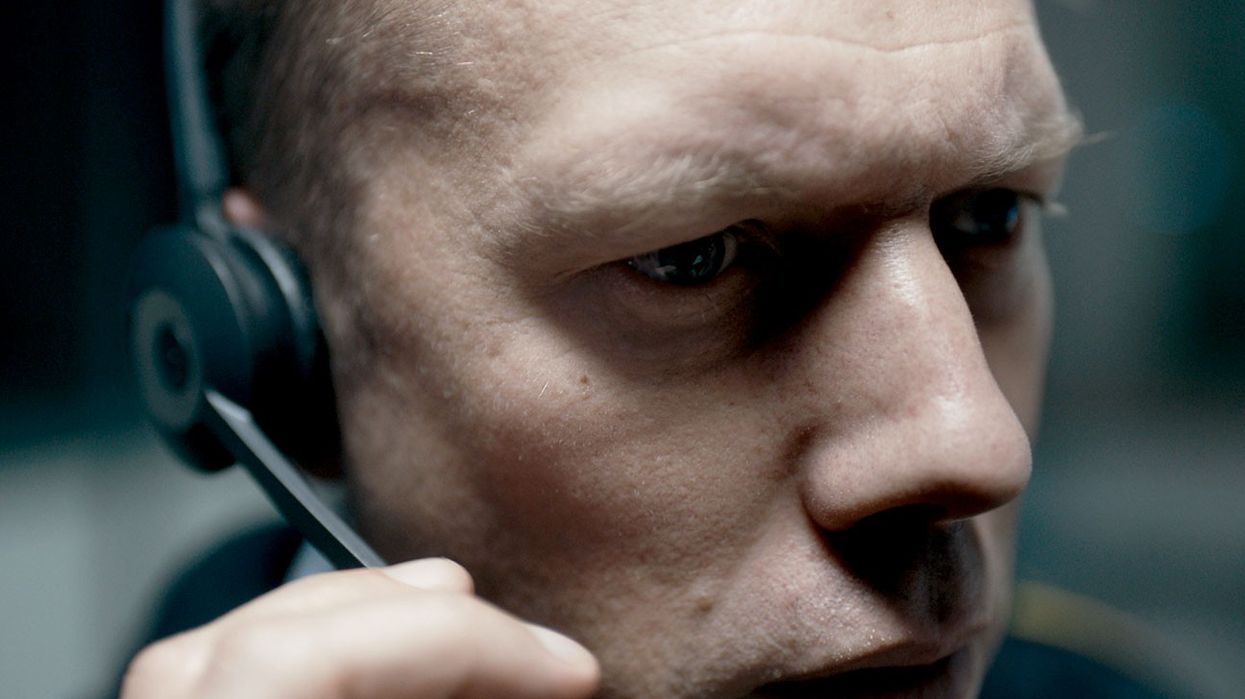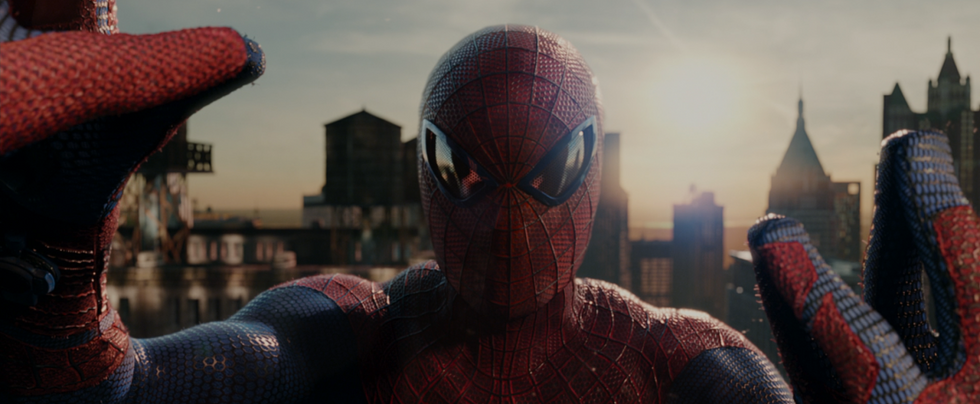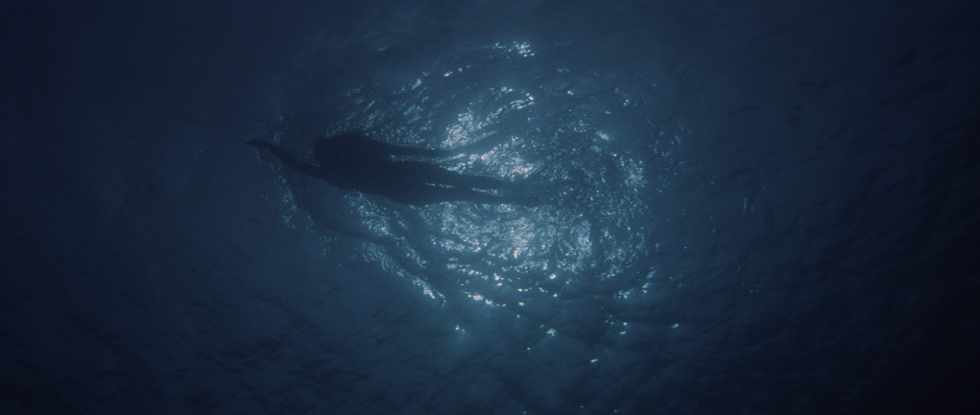'The Guilty': The Pulse-Pounding Crime Thriller Set on One Side of a Phone Call
In Gustav Möller's exhilarating, twisty thriller, all of the action takes place in a 9-1-1 call center.

Perhaps the most underutilized tool in a director's arsenal is the imagination—and not theirs, but the audience's. First-time director Gustav Möller knows this better than anyone. His thriller, The Guilty, which won the Audience Award in the World Cinema Dramatic Competition at this year's Sundance Film Festival, harnesses the power of the viewer's own imagery to upend our expectations until the very last moment.
The Danish film stars Jakob Cedergren as Asger, a police officer who, due to an ongoing investigation, has been temporarily demoted to a 9-1-1 dispatch call center. In the span of 90 minutes, which we experience in real-time, Asger receives a frantic call from a kidnapped woman named Iben (Jessica Dinage) and attempts to save her. As her abductor listens on, Asger instructs Iben to feign speaking on the phone to her daughter, and through "yes" and "no" questions and various codes, he tries to locate the vehicle in which she is trapped. But as her situation grows more dire, Asger becomes frustrated with the limited scope of his duties. He goes rogue and launches a simultaneous investigation, instructing police officers to break into houses that may provide salient information as to where Iben's kidnapper is headed. But, as he discovers, sincere intentions can have devastating consequences.
Because Asger—and the audience—can only assess the situation from his side of the phone call, we are forced to make inferences based on limited and subjective aural information. Through tightly engineered storytelling, Möller and his team deliver a suspenseful ride in which the audience's imagination is the true perpetrator.
No Film School sat down with Möller, a first-time director, and Cedergren, whose powerful performance bolsters the film, at the 2018 Sundance Film Festival. We discussed shooting with three cameras and on cinemascope, the directing technique he stole from Sidney Lumet and Al Pacino, and how to construct a crime thriller that positions itself squarely in the realm of moral ambiguity—or, as Möller described it, "a genre film that deconstructs its own premise." The films screens in New York City this weekend as part of MoMA and the Film Society of Lincoln Center's New Directors/New Films.

No Film School: How did you first conceive of the idea of setting the film in one room and telling the story from one perspective?
Gustav Möller: I stumbled across a YouTube clip—a real recording of a 911 call. And at first, I was just gripped by how suspenseful it was just listening to sound. But the really big thing for me was the fact that I felt like I had seen images, even though I had only listened to sound. And I also realized that every single person listening to that sound clip would see different images. I thought there was an amazing opportunity there to work with imagery. I thought that was a great premise for working with the genre of mystery and crime.
Then, my co-writer, Emil Nygaard Albertsen, and I started doing research at local dispatch centers in Denmark. And that's how it went from an idea to becoming a story. We started finding these characters from research.
NFS: One of the most impressive things about the film was the way in which you upended expectations until the very last minute. During the writing process, how did you organize the information such that it would achieve maximum suspense?
Möller: That was the major work we did in the script—how to distribute exposition. An inspiration for this was the podcast Serial. In the first season, we were really inspired by how gradually you get more information about the case in every episode, and as you do, the imagery of the people and the locations change. We worked a lot with that in the writing, but I will say that a lot of it was done in the editing room. The editor, Carla Luff, should have a bit credit in that. Towards the end of the editing process, she peeled off information more and more for every cut. That was because we felt that just by looking at him—at his eyes—there is a mysterious backstory.
Jakob Cedergren: It's minimalistic.
Möller: Yeah. In Danish, the exact translation is "under-told."
NFS: So, how did you two find each other?
Cedergren: Auditioned. Very old-school!
Möller: I did an audition with seven different actors, and the only thing that they had in common is that people thought they were the best actors in Denmark. I didn't go for a type or anything. This was at a very early stage—we didn't even have a first draft. I just wanted to watch these actors speak on the phone. I wanted to see who was the most intriguing to watch. The major thing I was looking for is: Am I getting drawn into watching this guy be on the phone?
Jakob has an intensity. It comes through in the eyes. It feels like he's keeping a secret from you. Jakob is the audience's portal into this world.
Cedergren: We talked a lot about the character and backstory that ended up not being told in the film. Even if you don't show it or hear it, I have to know it. Then, the rest of the character I had to draw out of the research process. Every time we visited the dispatch center, I learned more. Like, some people who work there are degraded police offices. So, why did that happen? What did they do? And so forth.
"The shortest sections we shot were five minutes a take; the longest one was a 35-minute take."
NFS: What was the shoot like?
Möller: So, we shot it in 13 days.
NFS: That's it? Wow.
Möller: We shot with three cameras. A few specific shots of him moving around we would do with [a single] Steadicam. But all of the scenes where he was on the phone were done with three cameras.
I wanted to shoot it in chronological order. With my DOP, Jasper Spanning, I cut the script into eight parts where we thought there was a change in the arc to give it a visual evolution. Of course, hopefully, it comes together ultimately as an organic flow. In each section, we would have a new concept. I asked myself, "What's the feel? Is it control? Is it distance?" We sometimes changed the more obvious things, like the way he pulls down the blinds at one point, or we changed the lighting to be more red towards the end. Sometimes we changed the optics: at the start of the film, we have a much shorter lens to have more distance, like in a classic thriller. As the film progresses, we change to wider lenses and get closer to him.
The shortest sections we shot were five minutes a take; the longest one was a 35-minute take. We would just do it again and again and again. I was quite inspired by Sidney Lumet. I knew I wanted to do these long takes when I heard an interview about Dog Day Afternoon. There was a scene where Al Pacino was on the phone with his wife and is totally exhausted. They wanted to do that as a 20-minute take. Towards the end of the take, when the 20 minutes have passed, instead of saying "cut," he just went, "Take it from the top, Al," and Al Pacino starts doing it again. In the film, they used the second take; the scene starts with Pacino looking down, exhausted. And that's him hearing the director say, "Do it again."
"Even when I thought we had a perfect take, I would say, 'Okay, let's do it from the top,' right after."
I was so inspired by how Lumet pushed the actor get in such a flow and how he really wears him down to a place where he is exhausted starts making these little mistakes. Towards the second half of the film, where [Jakob's] character is getting more desperate and disillusionized, I didn't want it to be like, "Okay, let's do this part where you're really shocked." I just wanted to throw him out there. Even when I thought we had a perfect take, I would say, "Okay, let's do it from the top," right after.
NFS: That must've been exhausting for you, Jakob!
Cedergren: Yeah, but, doesn't feel like that when you're doing it. The exhaustion comes afterward. When you're in it, you're in it. There's some kind of energy. It's beautiful. On set, you have everybody ready—20 people just ready to go, on the same page. It just hits you like this fantastic wave. It's like theater; no two nights are the same.
Möller: And I think the whole crew had a lot of respect for Jakob's situation.
Cedergren: If they didn't, I would make them. [Laughs]
Möller: The intensity really made people focused and engaged. It didn't feel like anyone was just standing around on set, looking at their phones.

NFS: Even though you had three cameras, it's an interesting challenge to shoot in a room that is not inherently interesting-looking.
Cedergren: It's a super boring room.
NFS: Very bureaucratic.
Möller: When I got out to the first dispatch center, I had expected something much more high tech. And then I saw this room that looked like a shitty office and I loved that. I loved that contrast of these cops dealing with life and death and they're sitting in this boring, kind of dirty room. So that's what I wanted in the production design. But I didn't want that in the cinematography. The main thing with the cinematography was focusing on the character. The choice of lens, framing, and everything else should be based on where he's at psychologically.
In regards to choice of framing, my DOP and I did all of our films together at film school. We love 235, or shooting scope. I know a lot of people say scope is not a portrait format—that it's a format for landscapes. But I love scope for portraits. You don't have to do a lot to make it look claustrophobic with a dead-on shot. I loved the way Steve McQueen and his DOP used cinemascope in Shame to make claustrophobic imagery. So, that was an inspiration.
"Editing the sound was like shooting the film all over again."
NFS: What were some of the more challenging aspects of bringing this film to life?
Möller: We discussed every line of the film. When Emil [Nygaard Albertsen], the co-writer, and I went through the script, we did it very thoroughly. So, that was intense, but it was a good challenge. And for me, that made the shoot pretty easy. We didn't have a lot of issues. It went smoothly!
Cedergren: As an actor, very often there's a part [of the script] that you don't understand. If that's not fixed, you're gonna have that same problem when you get on set, and it's gonna hurt the scene, especially during a shortage of time. So in my experience, it's important to get the script as pitch-perfect as possible.
NFS: Can you tell me about the process of editing sound on this film? It must have been exhaustive, too.
Möller: On my previous short films, I have gone in once a week towards the end to give notes on the sound edit. For this, we had a supervising sound engineer and another sound engineer. They were working eight weeks each on just the sound of the film. I was there every single day of that period, for full days. Editing the sound was like shooting the film all over again. I would actually rewrite some things. I wanted to evoke visuals for locations [on the other end of the phone call], and we had to come at that in the sound edit.
NFS: What are some examples of a scene that really changed in the sound edit?
Möller: One concrete example without spoiling the film: In the last scene, Jakob has a monologue towards the end. When we shot it, that wasn't a monologue. That was a dialogue. He was saying things and [the other character] was reacting to them by asking him questions and so forth. I realized it was stronger if we removed her dialogue; then, he had these pauses in his monologue, and it felt like he was sharing his story because of what was coming from inside of him.

NFS: During the research process, what did you discover about people's eroding trust in the police and the justice system? And what about the challenges police have to face every day on the job? Is there a way to bridge the gap?
Cedergren: Well, for me, when I went into the research, what I found was it was not so much about being a police officer; it was more about being put in a situation that you didn't really ask for. And from that, you kind of did some things and got scars from them. I felt it was a universal story about "doing what I was told to do," and, as a result, having your life changed.
Möller: I met with police officers, but I also had Jakob meet with people who had been at war. I wanted him to see what it does to a person to be faced with violence and darkness every day—what that does to your perception of other people and the world around you.
What I ultimately took away from the research is that there isn't any black and white or good or evil. Hopefully, that is also how the film feels: it starts out telling a story that is black and white and ends up in a gray area.
Some people in law enforcement have a judgemental approach, but I don't think it necessarily has to come from bad will. I think it can also be a result of being faced with darkness every day. It can be a defense mechanism. But I didn't come away with any answers, really. Just the fact that it's a very complicated matter.
NFS: More than answers, the film gives us perspective. I think any good film should do that.
Möller: Yeah. And that was also why I was intrigued working in the genre of the crime thriller, where you often deal with wrong and right and good and evil, and one wins. I think it was fascinating to tell a story where no such thing exists. This is a genre film that deconstructs its own premise.

 'The Amazing Spider-Man' (2012)
'The Amazing Spider-Man' (2012) 'Jaws' (1975)
'Jaws' (1975)









